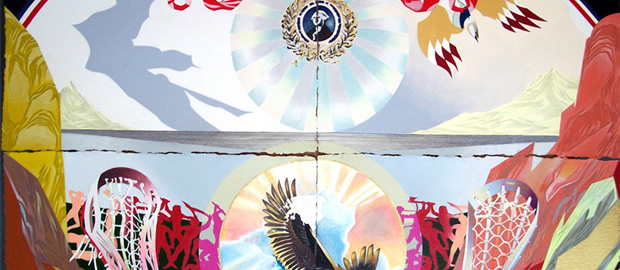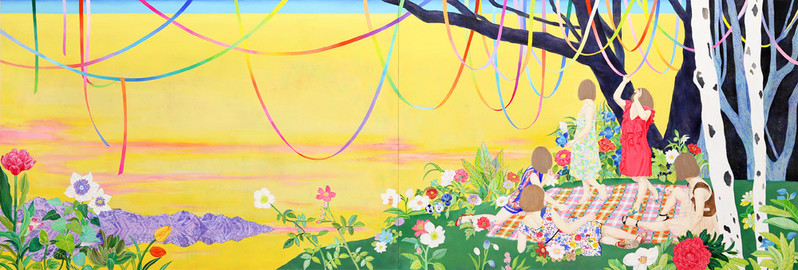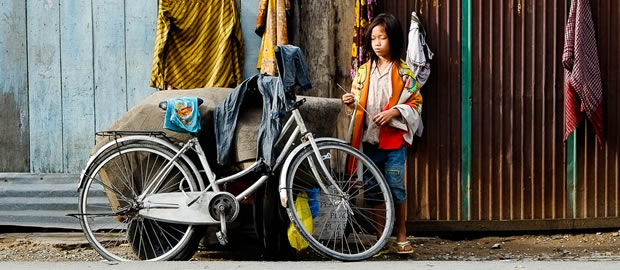Minnesota born Anishinaabe/European artist Andrea Carlson is an artist whose work takes the viewer into a politically charged object-filled world focusing on cultural narratives and stories offering commentary on museums, collections, and storytelling.
An Aboriginal artist of Haida and Québécois descent, Raymond Boisjoly is a Vancouver-based multidisciplinary artist who uses print-based sculptural media and installations to engage with the mediated representation of Aboriginality, while challenging cultural belief systems.
Through his work, Feodorov addresses contemporary issues of environment, consumerism, and spirituality. Away from his sound and video work, he is also producing art on paper and canvas, creating “hybrid mythical iconographies” that tackle issues such as environmental disaster and post-Colonial identity. Currently an Associate Professor of Art at Fairhaven College of Interdisciplinary Studies at Western Washington University, Feodorov’s art has been recognized in the publications Time and Time Again, by Lucy R. Lippard and Manifestations, edited
by Nancy Marie Mithlo, and in the PBS series Art 21: Art for the 21st Century. Statement by Artist In 1979, the largest accidental release of radioactive material in USA history happened in Church Rock in the state of New Mexico. A tailing dam burst, sending eleven hundred tons of radioactive mill wastes and ninety million gallons of contaminated liquid pouring toward Arizona into the Rio Puerco River. Today, the Navajo communities still cannot use the water.
Daughter of a traditional storyteller and a member of the Seneca Cayuga Tribe of the Iroquis Nation, video and performance artist Amelia Winger-Bearskin uses conceptual art to create fun and funky works that challenge the status quo.
Winger Bearskin is a trained opera singer and holds a master’s degree in art from the University of Texas. Her work
as a solo performer has seen her feature at numerous international performance festivals in cities including Seoul, New York, Beijing, and Manila.
Born in 1985, Naomi Okubo is a contemporary artist from Japan that is interested in the relationship between oneself and others or society and a contradiction that happen among the relationships. From an early age she was not sure how to relate with other people since she was afraid of what others would think about her.
Those feelings were expressed by his series of paintings from 2006 up to 2010 mostly showing his plural self-portraits in an effort to escape from those fears by merging all them people in the world as herself. Since 2010 Naomi wanted to express herself through his own experience and as a result, she changed his art expression by using ready-made images from fashion advertisements or interior
magazines into his paintings, trying to understand painting composition rather than the contents themselves From 2012 and on Naomi obviously feels better about herself, even though she is always interested of other people's opinions, so she returned to his original expression in art, painting the way that she should connect to the societies he is involved with! Below you can enjoy his 2013 series of paintings.
Tim Kelsall is a professional social scientist and amateur photographer living in Phnom Penh at Cambodia where he is shooting photos in his spare time.
Tim Kelsall is a professional social scientist and amateur photographer living in Phnom Penh at Cambodia where he is shooting photos in his spare time. Even though he calls himself an amateur photographer his work shows that he is more than that. In his latest blog post he is covering the ethics behind Street Photography while "Capturing the order within this chaos [...]of street photography in Phnom Penh" Tim while doing street photography tries not to offend people by taking their pics , for that same reason he believes he won't be
a great street photographer as this genre is defined by great photographers such as Henri Cartier-Bresson and Elliott Erwitt, famous for shooting their subjects while being "themselves" invisible and in the danger to upset people just after their pic is taken. Tim Kelsall definition of street photography is more related to a modern laography(somewhat synonym for Folklore) where the photographer seeks to capture and document moments of people's everyday life than shoot only the most awkward and bizarre of those moments. Below you can check out some of his Phnom Penh Street Photography sessions.





